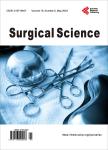Membrane Proteins as Potential Colon Cancer Biomarkers: Verification of 4 Candidates from a Secretome Dataset
Membrane Proteins as Potential Colon Cancer Biomarkers: Verification of 4 Candidates from a Secretome Dataset作者机构:Division of Colon and Rectal Surgery Chang Gung Memorial Hospital Linkou Chinese Taipei Graduate Institute of Clinical Medical Sciences College of Medicine Chang Gung University Taoyuan Chinese Taipei Graduate Institute of Biomedical Sciences Chang Gung University Taoyuan Chinese Taipei College of Medicine Chang Gung University Linkou Chinese Taipei Department of Public Health Chang Gung University Taoyuan Chinese Taipei Pathology Core of the Chang Gung Molecular Medicine Research Center Taoyuan Chinese Taipei Department of Biochemistry and Molecular Biology Chang Gung University Taoyuan Chinese Taipei
出 版 物:《Surgical Science》 (外科学(英文))
年 卷 期:2014年第5卷第10期
页 面:418-438页
学科分类:1002[医学-临床医学] 100214[医学-肿瘤学] 10[医学]
主 题:Biomarker Colorectal Cancer Immunohistochemistry Membrane Protein Secretome Tetraspanin-6 Transmembrane 9 Superfamily Member 2 Tumor-Associated Calcium Signal Transducer 2 Tumor Necrosis Factor Receptor Superfamily Member 16 Verification
摘 要:Colorectal cancer (CRC) is an important health issue in Taiwan. There were over ten thousand newly diagnosed CRC patients each year. The outcome of late stage CRC still remains to be improved, and tumor markers are expected to improve CRC detection and management. From a colorectal cancer cell secretome database, we chose four proteins as candidates for clinical verification, including tumor-associated calcium signal transducer 2 (TROP2, TACSTD2), transmembrane 9 superfamily member 2 (TM9SF2), and tetraspanin-6 (TSPAN6), and tumor necrosis factor receptor superfamily member 16 (NGFR). Different groups of 30 CRC patients’ tissue samples collected from Chang Gung Memorial Hospital were analyzed by immunohistochemistry (IHC) for the four proteins, and the results were scored by pathologist. For all the four candidate proteins, marked differences of IHC score existed between tumor and adjacent non-tumor counterpart. However, there were only trends between higher protein expression levels and worse outcome. Three proteins (TROP2, TM9SF2 and NGFR) had trends between higher tissue expression and tumor stage or lymph node metastasis. Our study revealed that tissue expression of four proteins (TROP2, TM9SF2, TSPAN6, and NGFR) was markedly different between tumor and adjacent non-tumor counterparts. Overexpression of all these four proteins showed some trends with poorer survival.



